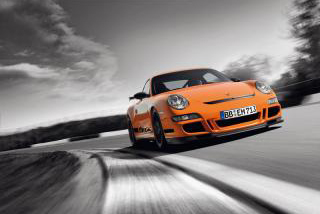
From the July 2010 Walrus Magazine
The racetrack I’m driving is a five-kilometre, eighteen-turn road course. Looked at another way, it’s just a strip of pavement that covers some arbitrary geography before ending up exactly where it started. That’s why, I think, friends tend to roll their eyes about my fixation with auto racing, yet wax philosophical about their own interest in baseball or golf or tennis. It’s just epically pointless, they feel, to go around and around and around like that, burning up tires and brakes and all that fossil fuel.
I don’t argue. Even enthusiasts occasionally reinforce this impression of motor sports as blindingly banal. “The lead car is absolutely unique,” the famed Formula One commentator Murray Walker once noted, “except for the one behind it, which is identical.”
Maybe. But only for the spectator and never the driver. Most people would assume I’m referring to the adrenalin, the thrill. And it is true that a Porsche GT3 — which is what I had the pleasure of racing recently on the track described above — does indeed go astonishingly fast. Three hundred kilometres an hour fast. Zero to 100 in 4.1 seconds. You can give yourself a G-force-induced sore neck in this car quite easily.
But while I like all that well enough, my obsession with racing has little to do with adrenalin. It is, instead, more like my obsession with chess — that is, a puzzle and a meditation. And this is perhaps why nobody is writing sonnets about racing. You really have to do it to get it, which is to say, you really have to drive breathtakingly fast to see what an immense ability this activity has to clear the head, to empty the psyche of disturbance, to calm and make one serene.
The puzzle of driving fast is intuitive. A track is a strip of pavement, as noted. It has turns and straight bits. Going fast in a straight line is elementary: you press the gas pedal until it hits the floor, and keep it there as long as possible. Going fast around corners, meanwhile, is a subtler bit of business. It involves finding and following a very specific path within the confines of the track surface, a path known as the racing line — you’re trying to drive as straight a line as possible, essentially.
On paper, you could solve this geometry puzzle pretty easily: you’re looking for the largest possible radius arc on the available pavement. In practice, it’s trickier. Sharp turns in particular have the peculiar feature — if you’re not content to drive around them slowly, that is — of requiring that you brake much later than seems like a healthy idea. Why? There’s a technical answer here involving trail braking and traction limits, acceleration attributes and opening radius arcs, but the truth is that people who’ve been around that corner a few hundred times will tell you you’re braking too soon. And their lap times prove the point.
But no matter how perfectly you read the line of a particular corner, you will never get around it fast unless you come to understand it as being linked to the corner before, until the whole track knits together in your mind to become a single thing. Where the hairpin sets up the chicane that sets up the sweeping right-hander into the long straight; mess up any one of those and your lap time will suck. Only through lapping can you discover the line and find the courage to drive it, braking and turning later, accelerating harder even to the limits of your tires when they’re shrieking and you can smell burnt rubber and feel the car go light on the road like it might just break free and spin off like a Frisbee into the desert.
Which brings us to the meditation. Sustaining a certain bass note of fear, paradoxically, racing also induces one of the finer trances I’ve ever experienced. This state arises because — golfers take note — you do not struggle to clear your head of other thoughts while racing. You do not waggle in place and wait for the moment. Midway through a lapping session, at the lip of the envelope, at the threshold limit of your grip on the surface of the earth, as you strain to hold on, to get around, to stay on the one true line, at that moment the only thing you struggle with is remembering your own name. You’re most emphatically there. No doubt about that. You’re just far too busy to notice yourself.
The racetrack will remain what it was all along — a five-kilometre, eighteen-turn strip of pavement that covers some arbitrary geography before ending up exactly where it started — but while you’re racing, you won’t experience it this way. The track will transform under you from circuitous to Ouroborosian. Self-consuming, self-regenerating. A universe of its own. Laced with energy. And yet transcendentally calm.

